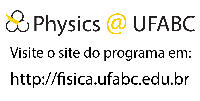PPGFIS
PÓS-GRADUAÇÃO EM FÍSICA
FUNDAÇÃO UNIVERSIDADE FEDERAL DO ABC
Telefone/Ramal:
(11) 4996-0154
E-mail:
ppg.fisica@ufabc.edu.br
http://propg.ufabc.edu.br/ppgfis
Banca de DEFESA: BRUNO PINHEIRO TONIATO
Uma banca de DEFESA de MESTRADO foi cadastrada pelo programa.STUDENT : BRUNO PINHEIRO TONIATO
DATE: 22/08/2025
TIME: 15:00
LOCAL: https://conferenciaweb.rnp.br/ufabc/defesa-mestrado-bruno-toniato
TITLE:
Holographic QCD and quarkonium melting: Finite temperature, density, and external field effects in self-consistent dynamical models.
PAGES: 120
BIG AREA: Ciências Exatas e da Terra
AREA: Física
SUBÁREA: Física das Partículas Elementares e Campos
SPECIALTY: Teoria Geral de Partículas e Campos
SUMMARY:
The discovery of the AdS/CFT correspondence, an instance of a gauge/gravity duality, has led to significant developments in modeling strongly coupled gauge theories. This theoretical framework therefore provides a novel approach for exploring non-perturbative phenomena in QCD and condensed matter systems. In this work, following a concise overview of the physical insights underlying the AdS/CFT correspondence, a self-consistent dynamical holographic QCD model is constructed within the Einstein-Maxwell-Dilaton (EMD) framework to investigate the mass spectra and melting behavior of heavy and exotic mesons at finite temperature and density. Unlike previous approaches, which introduced a non-quadratic dilaton profile by hand, this model is derived by solving the coupled Einstein, Maxwell, and dilaton field equations, thus ensuring mathematical self-consistency. At finite temperature, the confinement-deconfinement transition is explored through a Hawking-Page phase transition, and spectral functions are computed to track the sequential melting of quarkonia as temperature increases. Extending the analysis to finite density, this work examines how varying the baryonic chemical potential affects meson stability, revealing significant modifications in spectral peaks and effective potentials. The results indicate accelerated melting of mesonic states in the deconfined phase with increasing chemical potential. Additionally, the dual representation of the small-to-large black hole transition is investigated, identifying a first-order phase transition line that ends in a second-order critical point. Interestingly, spectral functions evolve smoothly across this transition. Furthermore, the melting behavior of quarkonia in an external magnetic field is examined using a dynamical Einstein-Born-Infeld-Dilaton (EBID) model. The nonlinear nature of this model allows the coupling of the magnetic field to the internal structure of quarkonia without introducing back-reacting charged flavor degrees of freedom. Spectral function calculations yield magnetic field-dependent melting temperatures, demonstrating a transition from inverse magnetic catalysis to magnetic catalysis as the magnetic field strength increases. Finally, it is discussed how spatial anisotropy, induced by the background magnetic field, influences the observed physical quantities.
COMMITTEE MEMBERS:
Presidente - Interno ao Programa - 1574260 - ROLDAO DA ROCHA JUNIOR
Membro Titular - Examinador(a) Interno ao Programa - 382324 - VILSON TONIN ZANCHIN
Membro Titular - Examinador(a) Externo à Instituição - GASTAO INACIO KREIN - UNESP
Membro Suplente - Examinador(a) Interno ao Programa - 1907614 - MAURICIO RICHARTZ
Membro Suplente - Examinador(a) Externo ao Programa - 1765195 - RICARDO ROCAMORA PASZKO
Membro Suplente - Examinador(a) Externo à Instituição - GAYANE KARAPETYAN - UFABC
Notícia cadastrada em: 15/07/2025 09:53
SIGAA | UFABC - Núcleo de Tecnologia da Informação - ||||| | Copyright © 2006-2025 - UFRN - sigaa-2.ufabc.int.br.sigaa-2-prod




